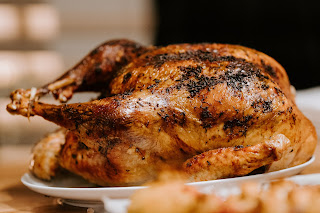Why is niacin added to flour? The understanding nutrients series
Here we are with another edition of the understanding nutrients series! We’re slowly working our way through all the vitamins and minerals with this monthly series. The nutrients I’ve already covered are here.
What is niacin?
Niacin is the proper name for vitamin B3. It’s a water soluble vitamin. This
means it’s not stored in the body and so you need to have it regularly from
your diet.
Why is niacin added to bread?
You may recognise the word niacin, or nicotinic acid, or nicotinamide from buying bread and other baked goods, as it’s compulsory for it to be added to white wheat flour in the UK.
This is because white flour is lower in nutrients, due to the processing of the wheat grain into white flour. So it's necessary for it to be added back in to ensure it's as nutritious as wholemeal wheat flour. Some other B vitamins and iron are also added back in.
As you read on, you’ll see why niacin is so essential.
Roles of niacin:
Niacin has many roles in the body.
Metabolism: one of the key roles of vitamin B3 is
supporting your metabolism – this is all the chemical reactions in your body.
This also covers converting the food you eat into energy that your body can utilise.
It works by niacin being converted into a coenzyme called NAD. NAD helps speed
up more than 400 chemical reactions, including the reactions that transfer
carbs, fat, and protein into energy that our cells use.
Antioxidant: another important role of vitamin B3 is its
function as an antioxidant. Antioxidants protect our cells from free radical
damage. Free radicals are unstable molecules that damage our cells, cause
aging, and cause illness. Antioxidants work by stabilising the free radical and
stopping it causing further harm.
How much niacin should you be having?
Niacin is an interesting vitamin as while we can get it
directly from food, our body can also make it from an amino acid called tryptophan.
Tryptophan is found in foods like poultry, tuna, and oats.
This means that the requirements for niacin are a bit
different too. It’s expressed as mg per 1000kcal, so the amount of niacin you
need will relate to the number of calories you consume. For adult men and
women, we need 6.6mg of niacin per 1000 calories. So, if you eat around 2000 calories a
day, you’ll need 13.2mg of niacin.
Foods that are sources of niacin:
Niacin is found in many foods like meat, fish, nuts,
legumes, and fortified products like bread or cereal. So, this isn’t an
exhaustive list:
- A medium slice of white bread (fortified) ~ 0.8mg of niacin
- A 30g bowl of rice krispies (fortified) has ~ 5.1mg of niacin
- 100g of tuna has ~ 17mg of niacin
- 100g of chicken breast has ~ 13.6mg of niacin
- 100g of pork chops has ~ 8.7mg of niacin
- 100g of baked beans has 0.7mg of niacin
- 100g of cannellini beans has ~ 1mg of niacin
- 25g of roasted peanuts has ~ 3.25mg of niacin
- 25g of almonds has ~ 0.9mg of niacin
What happens if you don’t get enough niacin?
You should be able to get all the niacin you need from a
healthy balanced diet. However a deficiency can occur if you have a genetic
disorder that prevents tryptophan being converted to niacin, a disorder that
leads to the malabsorption of nutrients, or alcoholism.
As you can see, vitamin B3 is very important!
Key points:
- Niacin or vitamin B3, is an essential nutrient that has roles in supporting your metabolism, promoting DNA repair, and acting as an antioxidant to prevent cell damage.
- Niacin can be made within the body from the amino acid tryptophan. We can also get it directly from food. Adults need 6.6mg of niacin per 1000 calories of food consumed.
- Sources of niacin include meat, fish, legumes, nuts, and fortified products like bread or cereal.
- A deficiency in vitamin B3 is called pellagra and it can lead to dermatitis, diarrhoea, and dementia.
I hope you enjoyed this post. I’d love to hear your thoughts
in the comments below.
Bye for now! 👋
References:
https://ods.od.nih.gov/factsheets/Niacin-HealthProfessional/
.jpg)





An interesting read, who would have thought it has so many different roles!
ReplyDeleteGlad you found it interesting!
DeleteThis comment has been removed by a blog administrator.
ReplyDeleteBest amazing blog i like it.
ReplyDeleteThank you!
Delete